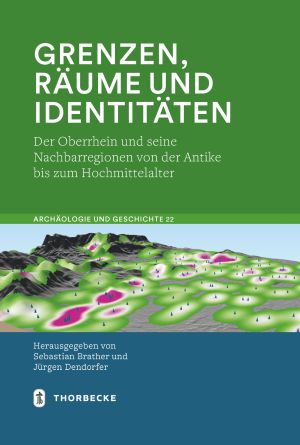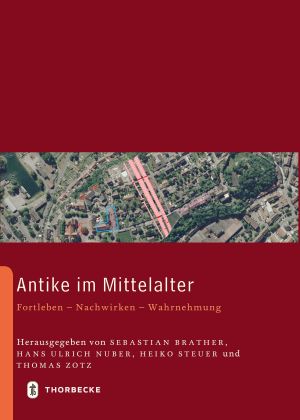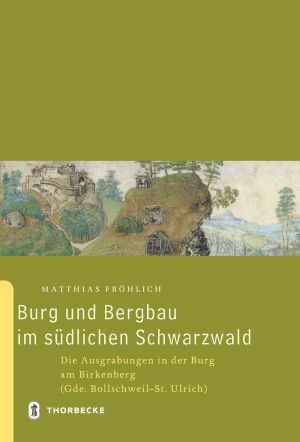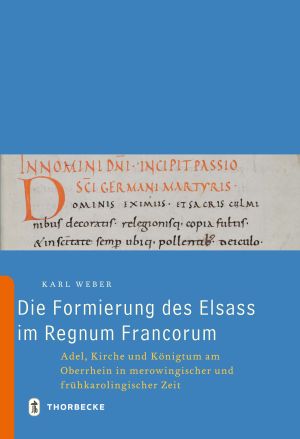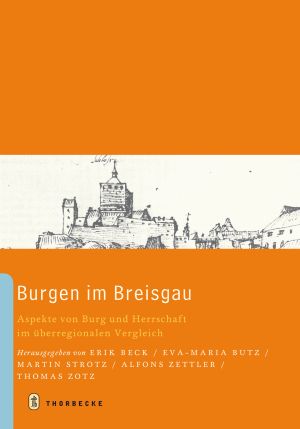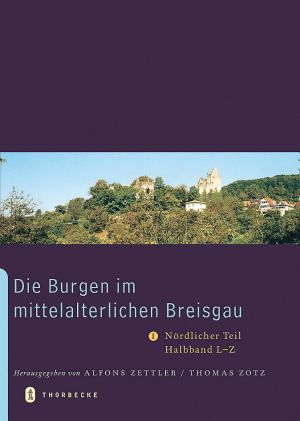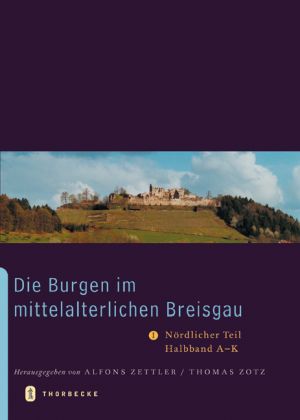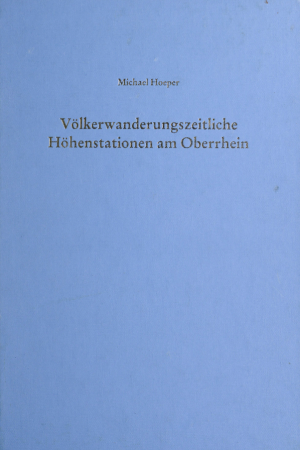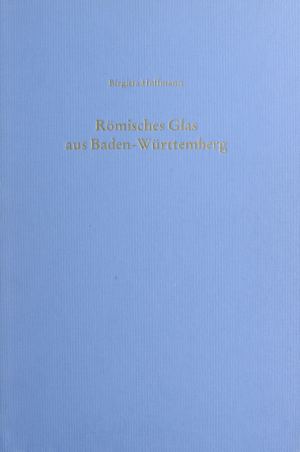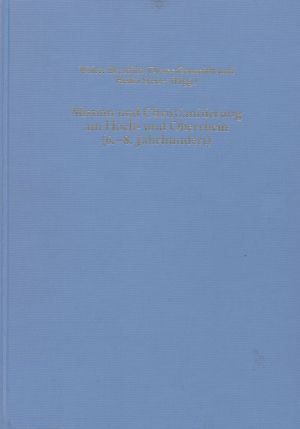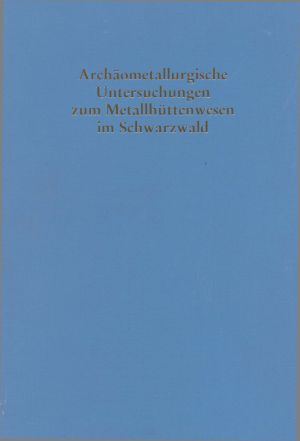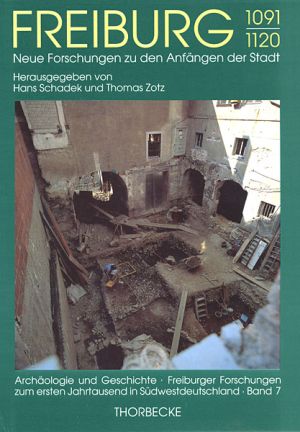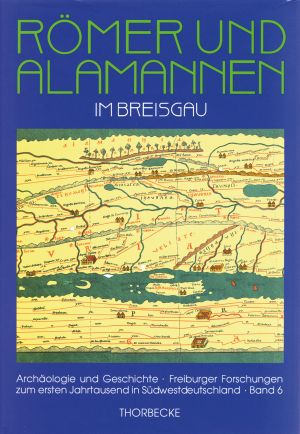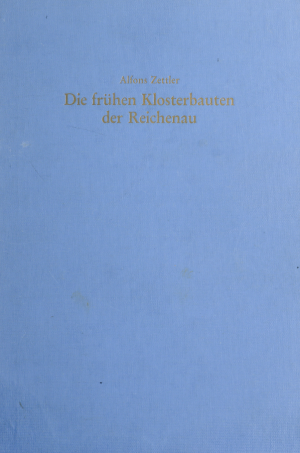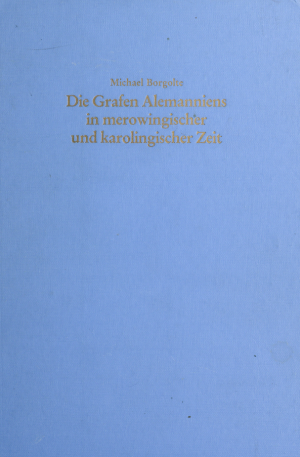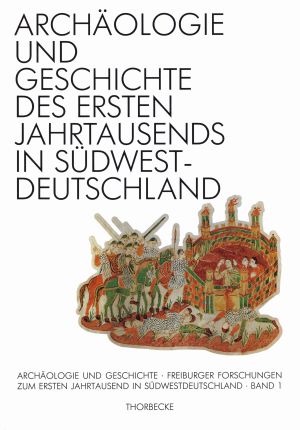Archäologie und Geschichte
Freiburger Forschungen zum ersten Jahrtausend in Südwestdeutschland
Freiburger Forschungen zum ersten Jahrtausend in Südwestdeutschland
Under the title „Archäologie und Geschichte. Freiburger Forschungen zum ersten Jahrtausend in Süddeutschland“ the research network „Archäologie und Geschichte des ersten Jahrtausends in Südwestdeutschland“ („Archaeology and history of the first millenium in southern Germany”) based at Albert-Ludwigs-University Freiburg has been publishing monographs and collected writings since 1986. Founded in 1984 it today comprises the subjects of prehistoric archeology, provincial Roman archeology as well protohistoric archeology and archeology of the middle ages, medieval history and regional history.
The aim of the research network is to use an interdisciplinary approach in exploring fundamental conditions and changes within the first millennium AC, conjecturing a “long” millennium dating from the pre-Roman iron age of the Celts and the Roman era until the high medieval era of town foundations. The research projects ranges from studies on Roman villas, mountain-top stations of the late antiquity, from late Roman border fortifications to late medieval castles, from the social structures of the early middle ages to the nobility groups of the high middle ages, from social identities to archaeo-metallurgy.
The volumes publish monographs, mainly exceptional dissertations as well as collected writings, compiling the papers of several conferences. The four volume handbook “Die Burgen im mittelalterlichen Breisgau“ (The castles in medieval Breisgau) is also part of this series.
The series is published with Thorbecke-Verlag, first in printed copies and then, with a moving wall of two years, free of charge online on this platform.
Current editors
Prof. Dr. Sebastian Brather
Prof. Dr. Jürgen Dendorfer
Prof. Dr. Alexander Heising
Prof. Dr. Christoph Huth
Internet: https://www.fvag.uni-freiburg.de
Published so far
Grenzen, Räume und Identitäten: Der Oberrhein und seine Nachbarregionen von der Antike bis zum Hochmittelalter
A new, preferably unbiased view of spatial structures proves to be a decisive prerequisite for freeing research from rigid assumptions and models. This makes it possible to replace previous and necessarily highly simplified dominant narrative with complex reconstructions. Beyond large lines, spatial relationships and structures prove to be flexible and changeable. The contributions collected in this volume underline how different approaches and perspectives can be, even when they deal with the seemingly self-evident "space". In this opening beyond deterministic concepts and conceptions of space, which geography has long since completed, there are new opportunities for archaeological and historical studies.
Antike im Mittelalter. Fortleben, Nachwirken, Wahrnehmung: 25 Jahre Forschungsverbund »Archäologie und Geschichte des ersten Jahrtausends in Südwestdeutschland«
A new, preferably unbiased view of spatial structures proves to be a decisive prerequisite for freeing research from rigid assumptions and models. This makes it possible to replace previous and necessarily highly simplified ladder counts with complex reconstructions. Beyond large lines, spatial relationships and structures prove to be flexible and changeable. The contributions collected in this volume underline how different approaches and perspectives can be, even if they deal with the seemingly self-evident "space". In this opening beyond deterministic concepts and conceptions of space, which geography has long since completed, there are new opportunities for archaeological and historical studies.
Burg und Bergbau im südlichen Schwarzwald: Die Ausgrabungen in der Burg am Birkenberg (Gde. Bollschweil-St. Ulrich)
In many valleys of the southern Black Forest are now mostly inaccessible tunnels and shafts that bear witness to the here in the Middle Ages operated mining on silver. In the older literature, these areas are often linked to nearby castles, on the assumption that local miners would have supervised the ore production and processing from there. At Birkenberg, about 10 km south of Freiburg im Breisgau, the remains of a castle complex were excavated for the first time within the scope of the "Burg & Bergbau" project financed by the German Research Foundation. Both the documentary tradition and the archaeological evidence ensure such a connection occupy. The research results are presented in this volume.
Burgen im Breisgau: Aspekte von Burg und Herrschaft im überregionalen Vergleich
Scholars from several nations and disciplines met in March 2009 in the former Cluniac Priory of St. Ulrich near Bollschweil to discuss aspects of medieval castles. The invitation was extended by the project group "The Castles in Medieval Breisgau" at the Universities of Dortmund and Freiburg i. Br., which aims at a complete survey of the castles of an old medieval landscape. At the conference, the results of many years of research were placed in a scientific context and compared on a supra-regional level.
Die Burgen im mittelalterlichen Breisgau: II. Südlicher Teil Halbband A–K
Of the once numerous castles in medieval Breisgau, only a few survived the turbulent and warlike centuries of the early modern period on the Upper and High Rhine. A small stock of more or less well-preserved ruins contrasts with a considerable number of vanished castles, of which only written records and field names still bear witness. The Burgenlexikon, which was compiled in cooperation between the Department of Regional History of the Historical Seminar of the University of Freiburg i. Br. and the Historical Institute of the Technical University of Dortmund, contains a richly illustrated catalog of all castles and castle sites of the Breisgau region in its medieval extent and thus offers for the first time a complete inventory of the high and late medieval castle landscape there. It will be published in four parts, of which so far the two volumes for the northern Breisgau and with this volume now also the first for the southern Breisgau are available.
Die Burgen im mittelalterlichen Breisgau: I. Nördlicher Teil. Halbband L-Z
Of the once numerous medieval castles in the Markgräflerland and in the Breisgau, only a few survived the eventful and warlike centuries of the early modern period on the Upper Rhine. A small number of more or less well-preserved ruins are contrasted by a considerable number of vanished castles, of which only written records and field names still bear witness. The Castle Book, which was compiled in the Department of Regional History at the Historical Seminar of the University of Freiburg i. Br., contains a richly illustrated catalog of all castles and castle sites in the Breisgau region in its medieval extension and thus offers for the first time a complete inventory of the high and late medieval castle landscape there. It will be published in four volumes, the first two parts covering the northern Breisgau, two more are planned for the southern Breisgau.
Die Burgen im mittelalterlichen Breisgau: I. Nördlicher Teil. Halbband A-K
Of the once numerous medieval castles in the Markgräflerland and in the Breisgau, only a few survived the eventful and warlike centuries of the early modern period on the Upper Rhine. A small number of more or less well-preserved ruins are contrasted by a considerable number of vanished castles, of which only written records and field names still bear witness. The Castle Book, which was compiled in the Department of Regional History at the Historical Seminar of the University of Freiburg i. Br., contains a richly illustrated catalog of all the castles and castle sites of the Breisgau region in its medieval extension and thus offers for the first time a complete inventory of the high and late medieval castle landscape there. It will be published in four volumes, the first two parts covering the northern Breisgau, two more are planned for the southern Breisgau.
Der Südwesten im 8. Jahrhundert aus historischer und archäologischer Sicht
On October 28 and 29, 1994, the Freiburg Research Network "Archaeology and History of the First Millennium in Southwest Germany" organized a colloquium at the University of Freiburg with the topic "The Southwest in the 8th Century from a Historical and Archaeological Perspective".
During the colloquium in 1994 such a period of upheaval was to be looked at more closely with the 8th century. This period, which cannot be strictly defined as a century, shows its transitional character in various respects, e.g. in political history with the striking end of the Alemannic duchy in the middle of the century and the integration of Alemannia into the Frankish Empire, in settlement archaeology with the flowing end of the row grave custom, the typical burial custom in the Merovingian Empire, and thus of the so-called row grave civilization. It was the intention of the colloquium to work out selective and long-term changes of this kind in the concentration on a region characterized by manifold historical traditions (Celts, Romans, Alemanni) as well as in the specific comparison with other historical landscapes and to approach the topic both in a general overview and in individual case studies.
Völkerwanderungszeitliche Höhenstationen am Oberrhein
Im Rahmen eines Projektes zu den »Spätantiken Höhensiedlungen am Oberrhein« konnten durch die Forschungen des »Instituts für Ur- und Frühgeschichte und Archäologie des Mittelalters« der Universität Freiburg in den letzten Jahren vier Höhensiedlungsplätze lokalisiert und teilweise auch archäologisch untersucht werden. Die Höhenstationen auf dem Geißkopf und dem Kügeleskopf liegen am Ausgang des Kinzigtales gegenüber dem spätantiken Legionslager von Straßburg auf der östlichen Rheinseite. Die große Zahl der Waffen, Werkzeuge und Beschläge spätrömischer Militärgürtel vom Geißkopf weisen darauf hin, daß sich auf diesem Berg vor allem Krieger und Handwerker aufhielten. Deshalb kann man hier eher von einem militärischen Stützpunkt als von einem Fürstensitz im Sinne des Zähringer Burgberges bei Freiburg ausgehen. Im vorliegenden Band wird das umfangreiche Fundmaterial der Höhenstationen auf dem Geißkopf und auf dem Kügeleskopf aus der alamannischen Frühzeit vorgestellt und analysiert sowie ihrer Deutung im Vergleich zu weiteren Höhensiedlungen, besonders im Oberrheingebiet, nachgegangen.
Mission und Christianisierung am Hoch- und Oberrhein (6. - 8. Jahrhundert)
The Christianization of the Germanic peoples of Western Europe began with the conversion of Clovis, king of the Franks, who, according to the report of the historian Gregory of Tours, vowed his conversion to the Christian Catholic faith in a battle against the Alemanni in 496/97. This event of "world historical significance" was recalled and honored in 1996/97, 1500 years after the legendary Battle of the Alemanni, in numerous events, exhibitions and publications. In March 1997, historians, theologians and archaeologists met in Bad Säckingen at the invitation of the city for a scientific colloquium to examine the missionary work and Christianization of the Alemanni, which probably began only decades after Clovis' baptism. The concentration on the area between the High and Upper Rhine and the interdisciplinary dialogue led to new insights and results, which are presented in this volume.
Frühe Alamannen im Breisgau: Untersuchungen zu den Anfängen der germanischen Besiedlung im Breisgau während des 4. und 5. Jahrhunderts nach Christus
Due to numerous excavations and new discoveries in recent years, the starting position for the exploration of the Breisgau region on the southern Upper Rhine in early Halamannic times has improved considerably. In late antiquity, the Breisgau was a border area between Romans and Germanic tribes. Roman castles on the Rhine on the one hand and Early Halamanian settlements on the plain and on the Black Forest rims on the other hand were partly in close proximity. Especially the extensively excavated settlement of Mengen on the Tuniberg and the hilltop settlement on the Zähringer Burgberg brought numerous new aspects to the archaeology and history of the early Alamanni.
The extensive analysis of the hand-formed Germanic pottery was a prerequisite for the assessment of the Early Alemannian settlement in the Breisgau region, since the pottery of the Early Alamanni shows formal similarities with the pottery of some prehistoric settlement phases, and there were often confusions. With this investigation it has been possible to highlight technological differences between the hand-formed pottery of early Alamanni and prehistoric times, which allow a clear attribution.
Archäometallurgische Untersuchungen zum Metallhüttenwesen im Schwarzwald
The subject of this volume is metal smelting in the Black Forest. A first contribution deals with technological developments in the prevention of lead, silver and copper ores in the period from the 11th to the 19th century. It provides the basics of metallurgy and describes, analyses and interprets the legacy of former smelting works from an archaeological and materials science perspective. A second article deals with the historical extraction and use of antimony ores. The work is published as Volume 8 in the series "Archäologie und Geschichte Freiburger Forschungen zum ersten Jahrtausend in Südwestdeutschland"
Freiburg 1091-1120: Neue Forschungen zu den Anfängen der Stadt
Die in Freiburg erst vor wenigen Jahren in Gang gekommene archäologische Erforschung des Stadtgrundes und der frühen Siedlungselemente, die vor allem in den Kellerbereichen von später neu errichteten Bauten erhalten blieben, hat die Diskussion um die Entstehung Freiburgs und um die Frühzeit der von den Zähringern begründeten städtischen Siedlung neu aufleben lassen. Die ältere Auffassung, die meinte, man halte mit dem berühmten Marktprivileg Konrads von Zähringen aus dem Jahre 1120 den urkundlichen Beweis für eine planmäßig durchgeführte Gründung der Stadt auf weitgehend unvorbereitetem Gelände in der Hand, sieht sich nun wieder mit der gegenteiligen, durch die archäologischen Befunde gestützten Ansicht konfrontiert, die die Entstehung Freiburgs als einen zeitlich gestreckten Vorgang zu deuten geneigt ist. Damit aber tritt auch das andere, von den Marbacher Annalen überlieferte, durch Eduard Heycks frühes Verdikt nie recht ernst genommene »Gründungsjahr« Freiburgs, nämlich 1091, wieder in das Blickfeld des Interesses. Es zwingt dazu, die Frage nach den Anfängen statt nach dem Anfang - von Markt und Stadt zu stellen. Diesen Versuch unternahm im »Jubiläumsjahr« 1991 die im vorliegenden Band vereinigte, vom Historischen Seminar der Universität und vom Stadtarchiv Freiburg veranstaltete Reihe von sieben Vorträgen. Es zeigte sich: Seit spätrömischer Zeit bot der gut strukturierte, durch Verkehrswege erschlossene weitere Raum um Freiburg günstige Voraussetzungen für eine wirtschaftliche Nutzung und intensive Besiedlung und damit für die Entstehung stadtähnlicher Zentren mit zentralörtlichen Funktionen wie Breisach, Sasbach, Riegel und die befestigte Großsiedlung auf dem Zähringer Burgberg. Seit den 1090er Jahren lagen die politischen Voraussetzungen vor für eine Konsolidierung der wirtschaftlichen Prosperität mit der Anlage einer jetzt archäologisch nachgewiesenen, unter dem Schutz der Burg auf dem Schloßberg stehenden Siedlung. Die Marktprivilegierung von 1120 schloß die vorausgegangene Phase organisatorisch und rechtlich ab. Auf diesem Fundament bildete sich der herrschaftliche Markt zur mittelalterlichen Stadt aus, deren sozial- und verfassungsgeschichtliche Entwicklung in den ersten anderthalb Jahrhunderten zwar im ganzen nur umrißartig, gelegentlich aber, vor allem im Hinblick auf die führenden Familien, unerwartet detailliert dargestellt werden kann.
Römer und Alamannen im Breisgau: Studien zur Besiedlungsgeschichte in Spätantike und frühem Mittelalter
Christel Bücker hat die römischen sowie frühalamannischen Keramikfunde vom Zähringer Burgberg bei Freiburg ausgewertet. Ihre Ergebnisse zeigen, dass die gewaltigen Baurnaßnahmen auf dem Burgberg in der Spätantike stattfanden und dazu dienten, die Bergkuppe zu einer etwa 5 ha großen ebenen Siedlungsfläche umzugestalten. Darüber hinaus wird die Keramik vorgestellt, woraus ein fortgeschrittener Grad der Romanisierung dieser alamannischen Oberschicht erschlossen werden kann. Die Studie bildet die Basis für alle weiteren kulturgeschichtlichen Auswertungen nicht nur zur Höhensiedlung auf dem Zähringer Burgberg, sondern auch zu den ländlichen Siedlungen in der Breisgauebene.
Michael Hoeper hat in seinem Beitrag alle frühalamannischen und merowingerzeitlichen Fundstellen, Siedlungen und vor allem Gräberfelder, registriert, ihre Verbindung zu den Ortsnamen analysiert und die Lage der Friedhöfe innerhalb der seit dem Anfang des 19. Jahrhunderts überlieferten Gemarkungsgrenzen beschrieben. Der Gang der Besiedlung ist für den gesamten Breisgau an der Abfolge der Ortsnamen und über die Reihengräber zu beschreiben. Auffällig ist die Beziehung zwischen den Orten auf -heim und den ehemals römischen Siedlungszentren. Außerdem wird das alte Modell des Besiedlungsbildes, dass die Siedlungen an der gleichen Stelle wie die heutigen Dörfer bestanden, ersetzt durch ein differenziertes Modell.
Hugo Steger greift eine aus dem 19. Jahrhundert überkommene Fehlinterpretation des Ortsnamens Riegel am Kaiserstuhl auf. Im Einklang mit zahlreichen lateinischen, altitalienischen und bairischen Belegen erweist sich das frühalthochdeutsche (8.Jh.) Femininum riegula/reigula aus lat. regula für Riegel als eine lateinische Bezirksbezeichnung. Die Frage einer civitas in Riegel kann damit neu diskutiert werden. Nicht ein alter Ortsname, sondern die Bezirksbezeichnung wurde als neuer Ortsname übernommen. Eine intensive Neuinterpretation antiker Geographien und Reisehandbücher sowie archäologischer und flurnamenkundlicher Zeugnisse für die römischen Hauptstraßen im Bereich Breisach – Wolfenweiler – Umkirch – Riegel begründet die Hypothese, dass der alte Ortsname für Riegel [H]Elvetum war.
Die Reichenauer Mönchsgemeinschaft und ihr Totengedenken im frühen Mittelalter
The Bodenseekloster Reichenau, founded around 724 by the Bishop Bishop Pirmin, has left in Reichenauer Fraternity Book and in two death books extensive name directories from the time before the millennium. Around 40,000 people were enrolled in these commemorative books during the earlier Middle Ages for the purpose of liturgical prayer. With the entry of the name in the commemorative books placed on the altar, the medieval man combined the idea of the entrance into the "heavenly book of life"; he hoped to have an everlasting presence in the liturgy and the prayers of the monks, closeness to God and the salvation of his soul. The core of the Reichenau memorial tradition, the lists of names concerning the Reichenau Convention and the memorial in the island monastery are the subject of this book. The traditionally edited and presented transmission complex not only reflects the varied history of the Abbey in Lake Constance and its monastic community from its founding to the Golden Age to the High Middle Ages, but also provides an insight into the history of Western monasticism and many aspects of social, political and ecclesiastical life of that time.
Montanarchäologie in Europa: Berichte zum Internationalen Kolloquium »Frühe Erzgewinnung und Verhüttung in Europa« in Freiburg im Breisgau vom 4. bis 7. Oktober 1990
Based on the papers presented at an international and interdisciplinary symposium (October 1990) in Freiburg/Br., this volume offers an overview of the latest montanarchaeological investigations in almost all of Europe. The more than 40 contributions span the time from prehistoric to early modern mining. The mining of gold and silver, of non-ferrous metals as well as of iron is taken into account, whereby the path from ore mining via smelting to the further processing of the raw metals is shown and keywords such as working conditions and environmental influences indicate the thematic diversity of the volume. The book, which is equipped with an extensive index of locations and more than 300 illustrations, vividly illustrates the research approaches, methods and previous results of mining archaeology.
Die frühen Klosterbauten der Reichenau: Ausgrabungen - Schriftquellen - St. Galler Klosterplan
Reichenau Monastery, founded in 724 by Bishop Pirmin, developed into a important sanctuary in the Franconian Empire during the eighth century. Equipped with a famous library and a well-known school, the Augia was one of the outstanding spiritual centers in early medieval Europe. Alfons Zettler has reconstructed the early architectural history of the monastery in years of research. His research draws from many written and pictorial sources. The focus, however, is the archaeological observations made by the author from 1970 to 1984 on site. In detail, he discusses the development of farm buildings, residential tracts and churches of the monastery district on the basis of the excavation findings. Maps, plans, historical views and photographs accompany the text. An appendix contains excavation documentation and remarks by Helmut Schlichterle on the prehistoric settlement of the monastery square. The book conveys important findings of modern medieval archeology and gives a fascinating insight into the everyday life of an early medieval monastic community.
Archäologie und Geschichte des ersten Jahrtausends in Südwestdeutschland
The research association "Archäologie und Geschichte des ersten Jahrtausends in Südwestdeutschland", founded in 1984, has set itself the goal of exploring the early history of the German southwest in an interdisciplinary conversation. The first volume of the series of the same name contains 15 contributions by renowned historians who present the latest results of research from their fields of activity - provincial Roman and early historical archaeology and medieval regional history. The geographical focus of the investigations is the area between the upper Rhine and the upper Danube, between the Swiss Jura and the Swabian Alb, the Burgundian Gate and the Franconian Ries. The time span ranges from the Celtic period and the Roman occupation of the country to the era of the formation of high medieval noble houses and sovereign territories. The research association pays special attention to periods of upheaval in history, the change of populations and the transformation of social and economic structures as well as the introduction of technical innovations. The book, which is equipped with an extensive index and many illustrations, provides a clear introduction to the methodology and working methods of ancient history. It is therefore an indispensable compendium for students and scholars, but also for the layman interested in regional studies.



